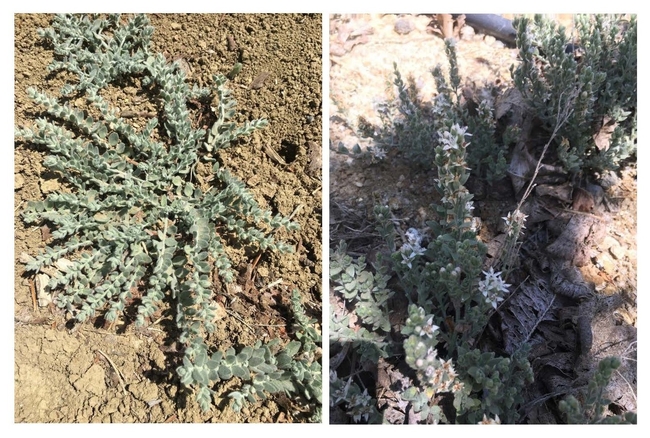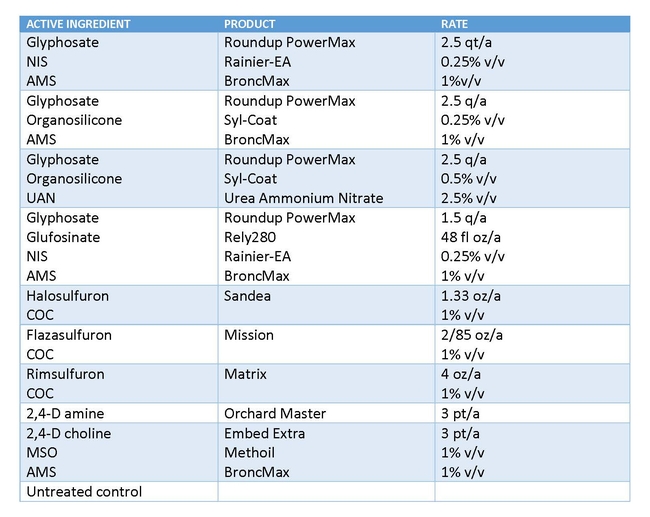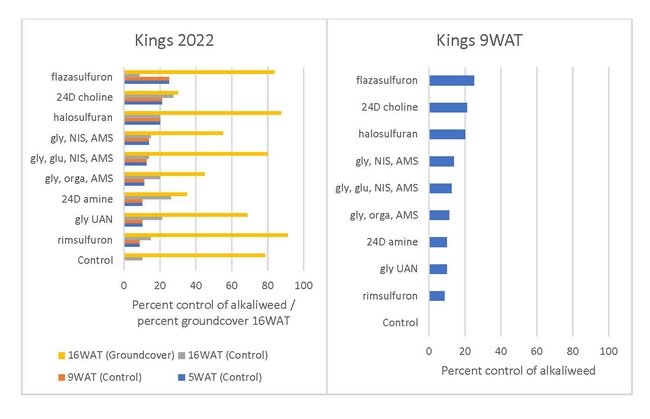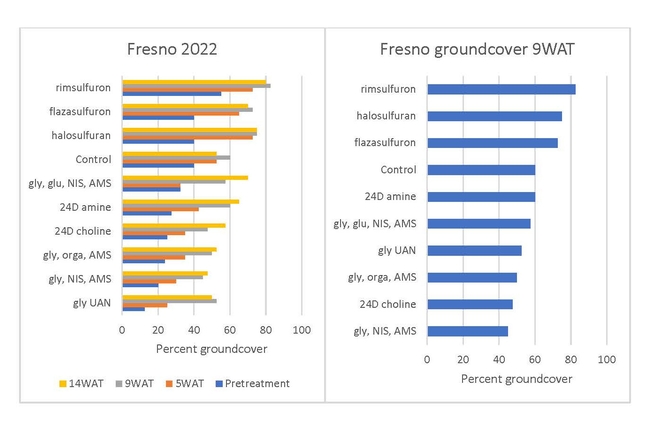Pistachio production has been expanding, particularly into marginal soils with high salts, boron, and even sodic conditions. One plant that is endemic to these conditions, alkaliweed, has been reported in these orchards. While there have been some articles suggesting that it it is a new weed to pistachio production, I am personally a bit skeptical of this, as it is endemic to the American Southwest, found as far south as Baja California, as far east as Texas, and has been reported in Ecuador, Argentina, and Chile. What is more likely is that pistachio production has been expanding into more marginal lands that already contain alkaliweed, and has been noticed more due to its extraordinary and frankly admirable ability to resist control with herbicides. However, this is speculation on my part – I very well may be proven wrong in the future.
Alkaliweed is a member of the morning glory family (Convolvulaceae), the same family as field bindweed. Similar to field bindweed, it is a plant that spreads via rhizomes (underground stems that can sprout new shoots and roots), and can spread and propagate asexually. Though there are ecological records of bindweed, we know very little about this plant. We have observed alkaliweed flowering profusely in agricultural settings, but in our own personal observations, in combination with those of a former Fresno State graduate student, James Schaeffer, we have not seen any seed production. It is often, but not always, found growing by itself in an orchard. We have also observed some sort of rust fungus growing on the underside of the leaves at all three of our research sites, though some sites seem to be more heavily impacted. It is unknown if this rust is found in non-orchard areas, or if it negatively impacts alkaliweed growth.
Alkaliweed gets its name based on the salty conditions it thrives in, which can be coastal areas as well as the arid southwestern San Joaquin Valley. Work done by James Schaeffer has shown that seed germination is highly tolerant of a wide range of soil pH levels as well as soil salinity; seed germination studies done in petri dishes showed that seed germination was uninhibited until 16 dS/m.
Alkaliweed is a small plant. It can either be fairly prostrate in its growth habit and reaching no more than an inch or two above the soil surface (Image 1a), or more upright, for a maximum height of approximately six inches (Image 1b). Individual plantlets are no more than 6 to 8 inches in diameter, and attempts at excavating it have shown that it seems to be connected to a deeper, more extensive rooting/rhizome system. The leaves are only a few millimeters across, green when they first emerge from the soil, and silvery-grey when older, due to leaf hairs on the surface of the leaf (trichomes). Flowers are borne at the base of an axil, and are just as tiny and as plentiful as the leaves (Image 1b). It has an uneven distribution in orchards; orchards with alkaliweed do not tend to be entirely infested, but rather have patches of heavy infestation and patches free of alkaliweed. It has been observed in monoculture type conditions as well as with other weeds – we do not know if it outcompetes other weeds or is so hard to kill that it ends up being the only weed left in an area.
Conversations with growers and other weed scientists have indicated that it is extremely difficult to control; our collaborators and fellow researchers have stated that no chemicals or cultural control methods seem to kill it. It was for this reason that we embarked on this research trial.
We conducted this trial at three different sites across the Southern San Joaquin Valley in 2021: a non-bearing orchard in Tulare County, and two bearing orchards in Kings and Fresno Counties. We chose areas within each orchard that were more heavily infested, and there were differences in how dominant alkaliweed was in the treated areas. The Fresno site was almost entirely composed of alkaliweed. The Tulare site was predominately alkaliweed but did have some alkali mallow present, and the Kings site had a more diverse mix of weeds, but was still dominated by alkaliweed.
We examined nine different herbicide treatments, and one untreated control (Table 1). Three of the treatments were glyphosate with different adjuvants; a nonionic fatty acid surfactant (Rainier-EA); or a silicone-based nonionic surfactant, with an ammonium-containing salt to stabilize the glyphosate. An additional treatment added glufosinate to the glyphosate+fatty acid surfactant. We examined three different sulfonylurea herbicides: halosulfuron, flazasulfuron, and rimsulfuron. All are phloem translocated herbicides that are effective at controlling broadleaved weeds, with some activity on sedges (halosulfuron, limited ability for rimsulfuron) or grasses (flazasulfuron, rimsulfuron). All were combined with a crop oil concentrate to increase penetration. Lastly, we looked at two different 2,4-D formulations: the traditional amine form and a choline formulation, which has a lower volatility than the amine formulation.
We applied these products three times: late-May of 2021, early November in 2021, and mid-April in 2022. All sites were evaluated based on percent control in 2021. In 2022, the Tulare and Kings site were also rated as percent control. The Fresno County site was rated on percent groundcover (again: alkaliweed was the only weed present at this site) to try to take into account any residual effects from the previous year. The Tulare and Kings sites were also rated based on percent weed groundcover for the last site rating.
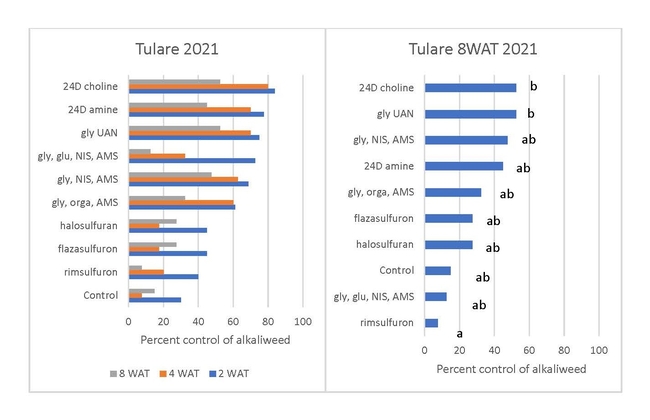
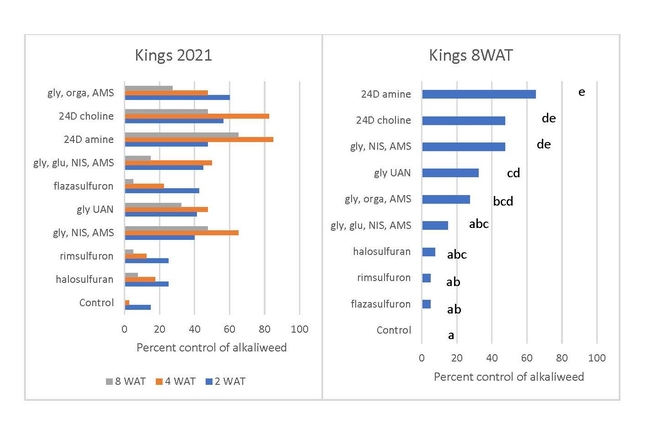
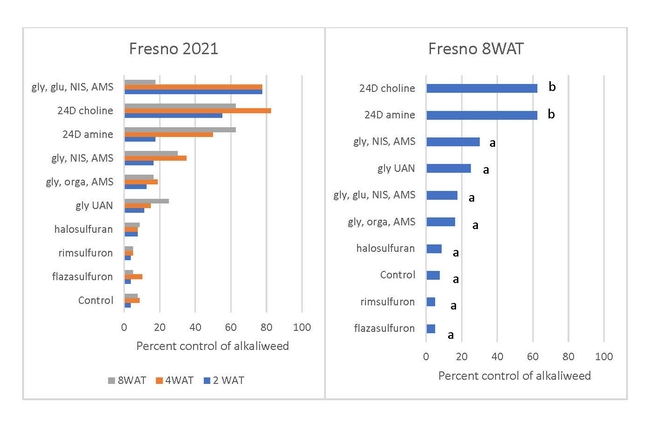
While there were significant differences across sites in 2021, none of the products adequately controlled alkaliweed after one application, though some products did have a fairly effective short-term burndown efficacy. In 2021, the 2,4-D choline treatment controlled alkaliweed significantly better than the control at all three sites (Figures 3, 4, 5), sometimes much better than the control. Alkaliweed response to glyphosate was variable, but generally this herbicide had less long-term control than 2,4-D (Figures 3, 4, 5). Glyphosate was ineffective at controlling alkaliweed at the Fresno site in 2021 (Figure 5).
Two additional herbicide applications partially controlled alkaliweed only at the Tulare site. Alkaliweed was poorly controlled at the Fresno and the Kings site. With the exception of rimsulfuron, applying an herbicide significantly increased alkaliweed control (Figure 6). The 2,4-D formulations and the glyphosate tank mixes without glufosinate were generally the best at controlling this perennial weed. The same was true 5WAT at the Fresno site (Figure 8), however the significant effects disappeared at later measurement dates (data not shown). For the most part, there were no significant differences between treatments at the Kings site in 2022 (Figure 7).
The research unfortunately does not show a slam dunk when it comes to alkaliweed control. At this point, 2,4-D seems to be the best choice, though glyphosate seems to have some effect. It is possible that yearly applications of 2,4-D, glyphosate, or a rotation of the two would result in underground storage organs becoming depleted of energy, eventually killing the plant, though this would need to be tested.
An added complication is that we were spraying small plots – a larger experiment that covers more land may reveal better control.
More work is being done to better understand the biology of alkaliweed. Stay tuned for more updates!
Thank you to our cooperators.
Phoebe Gordon, Caleb Crawford, Elizabeth Fichtner, and Doug Amaral are UC Cooperative Extension. Seth Watkins and Brad Hanson are with UC Davis.
